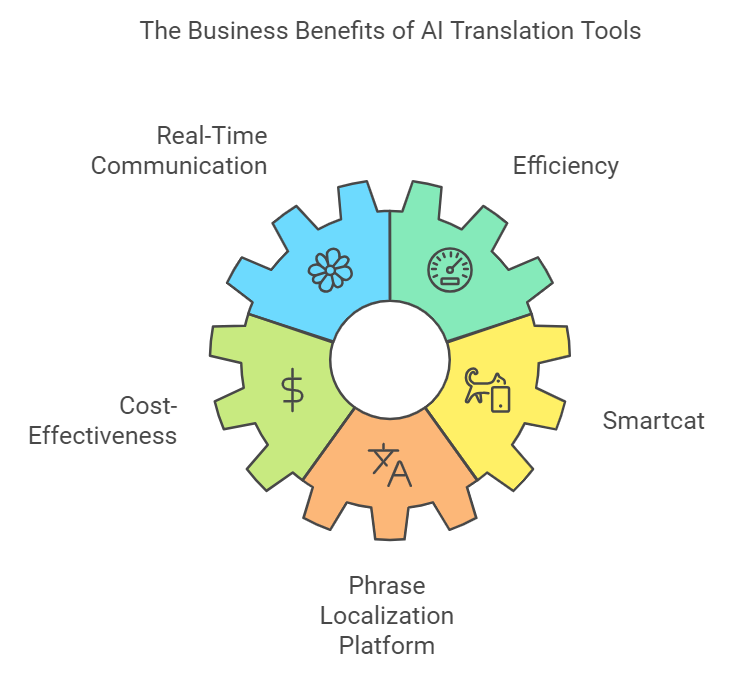The Role of AI
in Modern Translation
18
Hey there! Ever wondered how artificial intelligence (AI) has been shaking up the world recently? Well, it’s not just about robots and sci-fi movies anymore. AI has been making waves in various fields, and translation is one of them. In this article, let’s explore how AI has revolutionized translation services, making our lives easier and more connected.
A Leap in Translation Services with AI
AI, with technologies like machine learning (ML) and Neural Machine Translation (NMT), has brought about a significant transformation in translation. Gone are the days when translations were merely rule-based and often missed the mark in terms of context and cultural nuances. NMT models, on the other hand, understand these nuances, making translations more precise and natural.
Imagine needing a document translated from English to Japanese. With traditional methods, this could take hours, if not days. But AI-powered tools can do this in a matter of seconds, and with impressive accuracy. However, it’s important to note that while AI has advanced translation greatly, human oversight is still crucial. Human translators ensure the final output captures all linguistic subtleties that a machine might miss.
AI-Powered Translation Tools
You might have heard of some popular AI translation tools like Google Translate, DeepL, and Amazon Translate. These tools are not only fast but also offer high-quality translations. They have become indispensable across various industries, especially in e-commerce, customer support, and software localization.
Why Businesses Love AI Translation Tools
- Real-Time Communication: These tools facilitate instant communication across different languages, making global business operations smoother.
- Efficiency: With AI, businesses can handle large volumes of translations quickly and accurately.
- Cost-Effective: AI tools reduce the need for extensive human translation services, saving costs without compromising quality.
Another set of platforms worth mentioning are Smartcat and Phrase Localization Platform. These integrate translation management and quality control features, enabling businesses to strategize their global content efficiently.

The Magic of Machine Translation Post-Editing (MTPE)
MTPE combines the best of both worlds: the speed and efficiency of machines with the expertise of human translators. Here’s how it works:
- Initial Machine Translation: The text is first translated using AI.
- Human Editing: A human translator then reviews and refines the translation for naturalness and consistency.
This hybrid approach is not only cost-effective but also enhances translator productivity. It ensures that the final translation is accurate, culturally appropriate, and contextually relevant.
Data Annotation: The Backbone of AI
Ever wondered how AI models become so smart? The answer lies in data annotation. This process involves labeling data to train AI models, ensuring they interpret various data types accurately. High-quality data annotation is critical, especially in fields like healthcare, finance, and automotive.
Amazon is a leader in this space, offering comprehensive AI and ML services through Amazon SageMaker and Amazon Comprehend. These tools make it easier for businesses to adopt AI technologies and leverage them for their needs.
Generative AI and Large Language Models (LLMs)
Generative AI, including large language models (LLMs) like OpenAI’s GPT, has shown great promise in translation tasks. These models can generate human-like text, perform summarization, and even translate content. However, they are not yet as fast or cost-effective as leading NMT engines. Companies like Lionbridge are exploring ways to integrate LLMs into their translation workflows to enhance efficiency and quality.
Beyond Translation: AI in Business Operations
AI’s role is not limited to translation alone. It also impacts various aspects of business operations, including:
- Inventory Management: AI-driven tools predict demand and optimize warehouse operations.
- Quality Control: AI-powered sensors, like those used by Labby Inc., provide real-time quality testing, improving operations in industries like dairy farming.
- Localization: AI helps in adapting products and services to different languages and cultures, ensuring they resonate well with local audiences.
Ethical Considerations in AI Translation
While AI has brought about remarkable advancements, it’s essential to address the ethical considerations. Biases in training data can affect translation accuracy, leading to misinterpretations. Ensuring cultural sensitivity and ethical use of AI in translation is crucial. Human translators play a vital role in refining AI outputs and ensuring precision.
Latest Words
AI is undoubtedly transforming multilingual communication and business operations. By providing accurate, efficient, and scalable solutions, AI is opening new horizons for global connectivity. The future looks promising, with ongoing advancements expected to further enhance the quality and accessibility of translations.
Before we wrap up, here’s a quick quiz for you to answer in the comments:
- What are the main benefits of using AI-powered translation tools in businesses?
- How does Machine Translation Post-Editing (MTPE) enhance translation quality?
- Why is data annotation critical in training AI models?
- Can you name a few industries where AI has a significant impact beyond translation?
Looking forward to your thoughts and answers!
